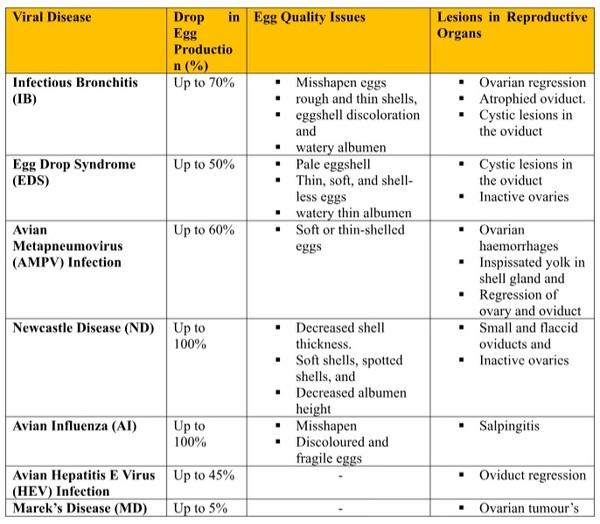Viral Infection & Ovarian Regression: What You Need To Know?
- Newcastle disease
- Marek’s Disease
- Infectious Bronchitis
- Avian influenza

1. Berg L.R., Bearse G.E., Hamilton C.M. The Effect of Newcastle Disease on Egg Production and Egg Quality. Poult. Sci. 1947; 26:614–622.
2. Box P.G., Beresford A.V., Roberts B. Protection of laying hens against infectious bronchitis with inactivated emulsion vaccines. Vet. Rec. 1980; 106:264–268. doi: 10.1136/vr.106.12.264.
3. Bwala D.G., Clift S.J., Duncan N., Bisschop S.P., Oludayo F.F. Determination of the distribution of lentogenic vaccine and virulent Newcastle disease virus antigen in the oviduct of SPF and commercial hen using immunohistochemistry. Res. Vet. Sci. 2012; 93:520–528. Doi: 10.1016/j.rvsc.2011.06.023.
4. Cook J.A., Orthel F., Woods M., Orbell S., Baxendale W., Huggins M. Avian pneumovirus infection of laying hens: Experimental studies. Avian Pathol. 2000; 29:545–556.
5. Crinion R.A.P., Ball R.A., Hofstad M.S. Abnormalities in Laying Chickens Following Exposure to Infectious Bronchitis Virus at One Day Old. Avian Dis. 1971; 15:42–48. doi: 10.2307/1588386.
6. de Wit J.J., Fabri T.H.F., Molenaar R.J., Dijkman R., de Bruijn N., Bouwstra R. Major difference in clinical outcome and replication of a H3N1 avian influenza strain in young pullets and adult layers. Avian Pathol. 2020; 49:286–295.
7. Lu Y., Lin D., Tasi H., Lee Y., Chui S., Lee C., Huang S. Outbreaks of egg drop syndromen1976 in Taiwan and isolation of the etiological agent. J. Chin. Soc. Vet. Sci. 1985; 11:157–165.
8. Meroz M., Elkin N., Hadash D., Abrams M. Egg drop associated with avian encephalomyelitis virus. Vet. Rec. 1990; 127:532.
9. Spencer J. Marek’s Disease. Scientific Basis and Methods of Control. Can. Vet. J. 1986; 27:190.
10. Wieliczko A., Mazurkiewicz M., Piasecki T., Kuszczyński T. The clinical course of the Infectious Laryngotracheitis (ILT) field case in hens and estimation of immunoprophylaxis efficiency. Pol. J. Vet. Sci. 2004; 7:143–147.









.jpg&w=3840&q=75)